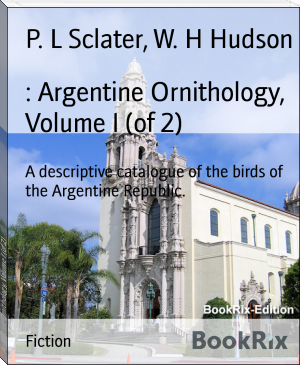: Argentine Ornithology, Volume I (of 2), P. L Sclater, W. H Hudson [best authors to read txt] 📗

- Author: P. L Sclater, W. H Hudson
Book online «: Argentine Ornithology, Volume I (of 2), P. L Sclater, W. H Hudson [best authors to read txt] 📗». Author P. L Sclater, W. H Hudson
and grey; tail black, tipped with white; bill and feet black; eye
olive-green: total length 9·2 inches, wing 4·2, tail 4·0. _Female_
similar, but smaller in size and lighter in colour.
_Hab._ Northern Patagonia.
The Patagonian Mocking-bird, which I met with during my sojourn on the
Rio Negro of Patagonia in 1871, closely resembles the species just
described, but is smaller, the plumage is of a darker grey, and the
irides are also of a darker green. It is a common bird, resident, lives
alone or with its mate, feeds on insects and berries, and in its manner
of flight and habits is like _Mimus modulator_. The nest is made in
the centre of a bush of thorns and sticks, and lined with dry grass,
cow-hair, or other soft material; and the eggs are four in number,
bluntly pointed, and thickly marked with dark flesh-coloured spots.
When the nest is approached the parent birds come close to the intruder,
often perching within a yard of his head, but without uttering any
sound, differing in this respect from _M. modulator_.
The song of the Patagonian bird is in character like that of the
northern species, the variety of its notes being apparently infinite;
there are, however, some differences worth mentioning. The singing
of the Patagonian species is perhaps inferior, his voice being less
powerful, while his mellow and clear notes are constantly mingled with
shrill ones, resembling the cries of some of the Dendrocolaptine birds.
While incapable of notes so loud or so harsh as those of the northern
bird, or of changes so wild and sudden, he possesses even a greater
variety of soft notes. Day after day for many months I have heard them
singing, yet never once listened to them for any length of time without
hearing some note or phrase I had never heard before. The remarks I have
made concerning the Calandria's mocking-faculties also apply to this
bird: but though he does not actually repeat the notes and songs of
other species, he certainly does mock the notes of individuals of his
own species; for it must be borne in mind that no two individuals sing
quite alike, and that the same bird constantly introduces new notes into
his song, and never repeats his notes in the same order. I have often
observed that when a bird, while singing, emits a few of these _new_
notes, he seems surprised and delighted with them; for, after a silent
pause, he repeats them again and again a vast number of times, as if
to impress them on his memory. When he once more resumes his varied
singing, for hours, and sometimes for days, the expression he has
discovered is still a favourite one, and recurs with the greatest
frequency. But this is not all. If the new note or phrase happens to be
a very striking one, it immediately takes the fancy of all the other
birds within hearing, and often in a small thicket there will be a dozen
or twenty birds near together, each sitting perched on the summit of his
own bush. After the new wonderful note has been sounded they all become
silent and attentive, reminding one in their manner of a caged Parrot
listening to a sound it is trying to learn. Presently they learn it,
and are as pleased with its acquisition as if they had discovered it
themselves, repeating it incessantly. I noticed this curious habit of
the bird many times, and on one occasion I found that for three entire
days all the birds in a small thicket I used to visit every day did
nothing but repeat incessantly two or three singular notes which they
had borrowed from one of their number. The constant repetition of this
one sound had a strongly irritating effect on me; but a day or two later
they had apparently got tired of it themselves, and had resumed their
usual varied singing.
This bird usually sits still upon the summit of a bush when singing,
and its music is heard in all seasons and in all weathers from dawn
till after dark: as a rule it sings in a leisurely unexcited manner,
remaining silent for some time after every five or six or a dozen notes,
and apparently listening to his brother-performers. These snatches of
melody often seem like a prelude or promise of something better coming;
there is often in them such exquisite sweetness and so much variety that
the hearer is ever wishing for a fuller measure, and still the bird
opens his bill to delight and disappoint him, as if not yet ready to
display his whole power.
8. MIMUS TRIURUS (Vieill.). (WHITE-BANDED MOCKING-BIRD.) [Plate I.]+Mimus triurus+, _Scl. et Salv. Nomencl._ p. 3; _Hudson, P. Z. S._
1872, p. 539 (Rio Negro); _White, P. Z. S._ 1882, p. 593 (Buenos
Ayres); _Burm. La-Plata Reise_, ii. p. 475 (Mendoza, Cordova, and
Tucuman); _Sharpe, Cat. B._ vi. p. 342.
_Description._--Above grey, brown on the rump; beneath light grey,
white on the belly; wing black, crossed with a broad white band;
tail white, except the two middle feathers, which are black; bill
and feet black; eye orange-yellow: total length 9·5 inches, wing
4·8, tail 4·2. _Female_ similar.
_Hab._ Paraguay, Argentine Republic, and Bolivia.
Azara first met with this king of the Mocking-birds in Paraguay a
century ago; he named it "Calandria de las tres colas," and described
the plumage accurately, but was, I think, mistaken about the colour of
the eye, which is orange-red and not olive-green. He says that it is a
rare species, possessing no melodious notes, which proves at once that
he never heard it sing. D'Orbigny obtained it in Bolivia, Bridges in
Mendoza, and more recently it his been found by collectors in various
parts of the Argentine country, even in Buenos Ayres, where, however, it
is probably only an occasional visitor. But they have told us nothing of
its song and of its miraculous mocking-powers. For my part I can think
of no other way to describe the surpassing excellence of its melody,
which delights the soul beyond all other bird-music, than by saying that
this bird is among song-birds like the diamond among stones, which in
its many-coloured splendour represents and exceeds the special beauty of
every other gem.
I met with this species on the Rio Negro in Patagonia: it was there
called _Calandria blanca_, a name not strictly accurate, since the bird
is not all white, but certainly better than Azara's strange invention of
"Lark with three tails."
The bird was not common in Patagonia, and its only language was a very
loud harsh startled note, resembling that of the _Mimus calandria_; but
it was past the love-season when I first met with it, and the natives
all assured me that it possessed a very wonderful song, surpassing the
songs of all other birds; also that it had the faculty of imitating
other species. In manners and appearance it struck me as being utterly
unlike a _Mimus_; in its flight and in the conspicuous white and black
of the wings and tail, it looked like a Tyrant of the _Tænioptera_
group. It was extremely shy, had a swift, easy, powerful flight, and,
when approached, would rise up high in the air and soar away to a great
distance. In February it disappeared from the Rio Negro and did not
return till the following October, after the arrival of all the other
migrants. It was then that I had the rare good fortune to hear it sing,
and I shall never forget the sensation I experienced when listening to
its matchless melody.
While walking through a _chañar_-wood one bright morning, my attention
was suddenly arrested by notes issuing from a thicket close by, and
to which I listened in delighted astonishment, so vastly superior in
melody, strength, and variety did they seem to all other bird-music.
That it was the song of a _Mimus_ did not occur to me; for while the
music came in a continuous stream, until I marvelled that the throat of
any bird could sustain so powerful and varied a song for so long a time,
it was never once degraded by the harsh cries, fantastical flights, and
squealing buffooneries so frequently introduced by the Calandria, but
every note was in harmony and uttered with a rapidity and joyous abandon
no other bird is capable of, except, perhaps, the Sky-Lark; while the
purity of the sounds gave to the whole performance something of the
ethereal rapturous character of the Lark's song when it comes to the
listener from a great height in the air.
Presently this flow of exquisite unfamiliar music ceased, while I still
remained standing amongst the trees, not daring to move for fear of
scaring away the strange vocalist. After a short interval of silence I
had a fresh surprise. From the very spot whence that torrent of melody
had issued, burst out the shrill, confused, impetuous song of the small
yellow-and-grey Patagonian Flycatcher (_Stigmatura flavo-cinerea_). It
irritated me to hear this familiar and trivial song after the other, and
I began to fear that my entertainer had flown away unobserved. But in
another moment, from the same spot, came the mellow matin-song of the
Diuca Finch, and this was quickly succeeded by the silvery bell-like
trilling song of the Churinche, or little Scarlet Tyrant-bird.
Then followed many other familiar notes and songs--the flute-like
evening-call of the Crested Tinamou, the gay hurried twittering of the
Black-headed Goldfinch, and the leisurely-uttered, delicious strains of
the Yellow Cardinal, all repeated with miraculous fidelity. How much
was my wonder and admiration increased by the discovery that my one
sweet singer had produced all these diverse strains! The discovery was
only made when he began to repeat songs of species that never visit
Patagonia. I knew then that I was at last listening to the famed White
Mocking-bird, just returned from his winter travels, and repeating in
this southern region the notes he had acquired in subtropical forests a
thousand miles away.
These imitations at length ceased, after which the sweet vocalist
resumed his own matchless song once more. I ventured then to creep a
little nearer, and at length caught sight of him not fifteen yards away.
I then found that the pleasure of listening to its melody was greatly
enhanced when I could at the same time see the bird, so carried away
with rapture does he seem while singing, so many and so beautiful are
the gestures and motions with which his notes are accompanied. He passes
incessantly from bush to bush, scarcely alighting on their summits, and
at times dropping down beneath the foliage; then, at intervals, soaring
to a height of a hundred feet above the thicket, with a flight slow as
that of a Heron, or mounting suddenly upwards with a wild, hurried,
zigzag motion; then slowly circling downwards, to sit with tail
outspread and the broad glistening white wings expanded, or languidly
waved up and down like the wings of some great butterfly--an object
beautiful to see.
When I first heard this bird sing I felt convinced that no other
feathered songster on the globe could compare with it; for besides the
faculty of reproducing the songs of other species, which it possesses in
common with the Virginian Mocking-bird, it has a song of its own, which
I believed matchless; and in this belief I was confirmed when, shortly
after hearing it, I visited England, and found of how much less account
than this Patagonian bird, which no poet has ever praised, were the
sweetest of the famed melodists of the Old World.





Comments (0)